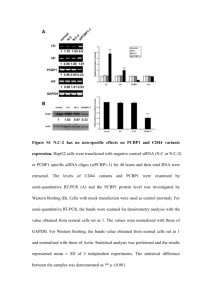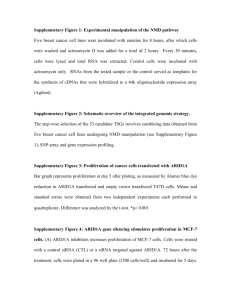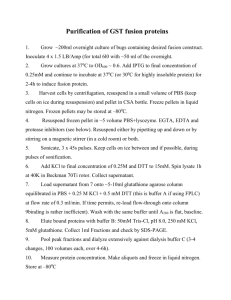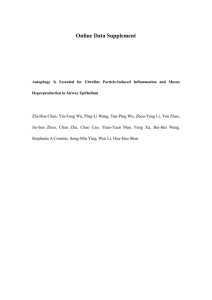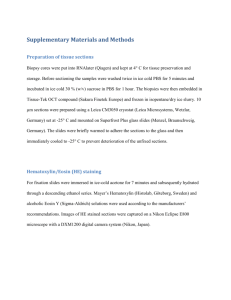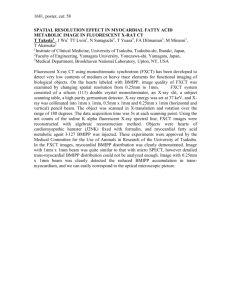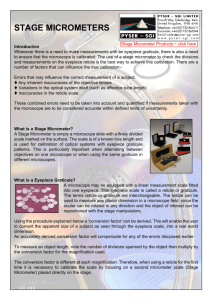Supplementary Information (doc 38K)
advertisement
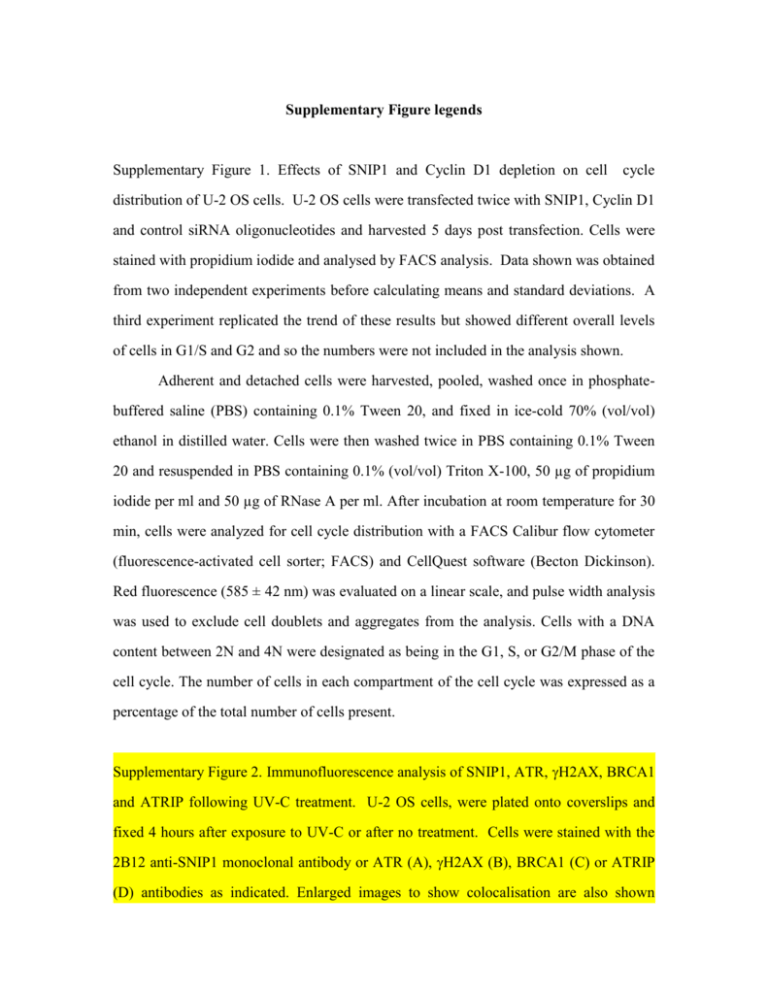
Supplementary Figure legends Supplementary Figure 1. Effects of SNIP1 and Cyclin D1 depletion on cell cycle distribution of U-2 OS cells. U-2 OS cells were transfected twice with SNIP1, Cyclin D1 and control siRNA oligonucleotides and harvested 5 days post transfection. Cells were stained with propidium iodide and analysed by FACS analysis. Data shown was obtained from two independent experiments before calculating means and standard deviations. A third experiment replicated the trend of these results but showed different overall levels of cells in G1/S and G2 and so the numbers were not included in the analysis shown. Adherent and detached cells were harvested, pooled, washed once in phosphatebuffered saline (PBS) containing 0.1% Tween 20, and fixed in ice-cold 70% (vol/vol) ethanol in distilled water. Cells were then washed twice in PBS containing 0.1% Tween 20 and resuspended in PBS containing 0.1% (vol/vol) Triton X-100, 50 µg of propidium iodide per ml and 50 µg of RNase A per ml. After incubation at room temperature for 30 min, cells were analyzed for cell cycle distribution with a FACS Calibur flow cytometer (fluorescence-activated cell sorter; FACS) and CellQuest software (Becton Dickinson). Red fluorescence (585 ± 42 nm) was evaluated on a linear scale, and pulse width analysis was used to exclude cell doublets and aggregates from the analysis. Cells with a DNA content between 2N and 4N were designated as being in the G1, S, or G2/M phase of the cell cycle. The number of cells in each compartment of the cell cycle was expressed as a percentage of the total number of cells present. Supplementary Figure 2. Immunofluorescence analysis of SNIP1, ATR, H2AX, BRCA1 and TRIP following UV-C treatment. U-2 OS cells, were plated onto coverslips and fixed 4 hours after exposure to UV-C or after no treatment. Cells were stained with the 2B12 anti-SNIP1 monoclonal antibody or ATR (A), H2AX (B), BRCA1 (C) or ATRIP (D) antibodies as indicated. Enlarged images to show colocalisation are also shown together with the region of the original image from which they originated. Since these are digital images, colour designation is arbitrary. The lack of a significant increase in ATR foci seen upon UV-C stimulation is a consistent effect and may reflect the antibody used or the time point chosen. Supplementary Methods siRNA transfection Cells were seeded at 8 x 104 cells per well in a 24 well plate and transfected the next day using Oligofectamine, as described in the manufacturers instructions (Invitrogen). siRNA duplex was used at 0.6 M. After 5 hours 500 l of complete DMEM media was added to each well. Cells were trypsinised the next day and the contents of two 24-well plates were then cultured in a 6 well plate for a further 48 hours before either being transfected again or being used in experiments. Cells undergoing double siRNA treatment (Figures 3C and 4A-C ) were used 5 days after initial transfection. All siRNAs used have been reported previously (Roche et al., 2004) except Cyclin D1, the sequence of which is: 5’ AUG UGU GCA GAA GGA GGU CTT 3’ Immunoprecipitation from HEK 293 cells HEK 293 cells were transfected with HA-tagged SNIP1 expression plasmids and 2 days later, whole cell extracts were prepared (WCE buffer: 20mM HEPES pH 7.6, 400mM NaCl, 1mM EDTA, 25% glycerol, 1mM DTT, 0.1% NP40). 500g total protein was then diluted 4.5 fold into immunoprecipitation buffer (20mM HEPES pH 7.9, 20% glycerol, 1mM DTT), 2g 12CA5 -HA antibody was added, and incubated with rocking at 4oC for 2 hours. Pre-washed Protein-A sepharose was then added for a further hour prior to 3x 1 minute washing (20mM HEPES pH7.9, 75mM KCl, 2.5mM MgCl2, 1mM DTT, 0.1% NP40). Samples were then resuspended in 2X SDS sample buffer and boiled for 5 minutes to dissociate the protein complex from the beads before SDS-PAGE analysis and western blotting. Immunofluorescence Microscopy For immunofluorescence, cells grown on coverslips were fixed after washing once in PBS by incubation in 3.7% formaldehyde/PBS (pH6.8) for 15 min. Cells were permeabilized in PBS-0.1% Triton X-100 for 15min and then blocked in PBS-0.05% Tween supplemented with 1% normal donkey serum for 30 min before addition of primary antibodies. All second antibodies (labeled with either FITC, X-Red or Cy5) were purchased from Jackson Laboratories. Images were acquired using a DeltaVision microscope and deconvoluted using SoftWorx (Applied Precision). Images were adjusted for brightness, contrast and, in Figure 4A & D and Supplementary Figure 2 for pixellation, using Adobe Photoshop. RNA Extraction and semi-quantitative PCR analysis Total RNA was extracted using either the RNeasy kit (Qiagen) or NucleoSpin RNA II kit (Macherey Nagel). 5-100ng of total RNA, depending on the target gene, was then used to perform PCR analyse using the Access-RT PCR system (Promega). PCR products were resolved by agarose gel electrophoresis and visualized by staining with ethidium bromide. PCR primers used in this study have been described previously (Campbell et al., 2004; Rocha et al., 2003a; Rocha et al., 2005; Roche et al., 2004). Gel Filtration HeLa nuclear protein extracts resolved by gel filtration were provided by Dr Kostya Panov (University of Dundee). Fractionation was performed using 4mg of nuclear protein extract made from proliferating HeLa cells. A Superose 6HR 10/30 column (Amersham Biosciences) column was used with an AKTA FPLC (Amersham Biosciences) and extracts were fractionated with a flow rate of 0.1 ml/minute. The buffer used was 150mM KCl, 25mM Tris-HCl, pH7.9, 12.5mM MgCl2, 0.015% NP40, 10% glycerol, 1mM DTT, 1mM MBS.
